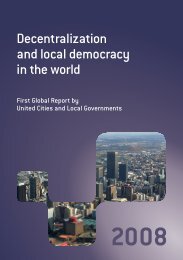Making Cities Resilient Report 2012
Making Cities Resilient Report 2012
Making Cities Resilient Report 2012
Create successful ePaper yourself
Turn your PDF publications into a flip-book with our unique Google optimized e-Paper software.
CHAPTER 5 | LOOKING FORWARD: WHAT ARE SOME POSSIBLE APPROACHES TO MEASURING RESILIENCE IN CITIES<br />
LOOKING FORWARD: WHAT ARE SOME POSSIBLE APPROACHES TO MEASURING<br />
RESILIENCE IN CITIES<br />
Local governments have expressed the need to benchmark their urban<br />
resilience efforts with clear quantitative indicators. This type of indicator will<br />
help local decision-makers prioritise resilience activities and understand the<br />
value of their investments in these areas.<br />
Several local governments noted that the HFA Local Government Self-Assessment Tool, developed under<br />
the <strong>Making</strong> <strong>Cities</strong> <strong>Resilient</strong> Campaign, has been important in helping them to understand and recognise<br />
priority areas for action; some plan to use it for benchmarking. The self-assessment tool offers many<br />
qualitative indicators for measuring resilience. These can serve as a reference and starting point for city<br />
managers, planners, engineers, architects and economists as they develop more quantitative indicators<br />
and standards for resilience building at city level, set targets and make improvements over time. For<br />
example, the indicator under Essential 1 of the self-assessment tool on the extent of partnerships for<br />
disaster risk reduction requires that local authorities determine how to quantify the effectiveness of those<br />
partnerships in reducing risk. Similarly, under Essential 6, the strength of existing land use regulations<br />
requires more exact parameters in order to measure what constitutes strong regulations. Annex 4 contains<br />
a summary table of city activities that were presented in Chapter 4, organised by the indicators that form<br />
part of the local-level self-assessment tool.<br />
Rather than defining precise indicators, this chapter presents ideas about what should be measured to<br />
understand urban resilience. It outlines what city managers and politicians consider appropriate indicators<br />
for resilience and is based on interviews conducted for this report. The indicators cited are context-specific<br />
and highlight that city-level indicators must be developed locally. This chapter also outlines possible<br />
indicators to help understand the resilience that urban centres may have already accumulated through<br />
the process of urbanisation, apart from specific resilience activities that directly address natural hazards.<br />
The former highlight the built-in resilience that is characteristic of well-governed cities, regardless of the<br />
impacts of natural hazards, but which are, nevertheless, important measures of resilience.<br />
This chapter also looks at two specific areas of focus as the campaign moves forward; urban planning and<br />
financing disaster risk reduction.<br />
The expanding body of literature on how to measure resilience reflects the growing interest across a<br />
variety of fields of inquiry. This includes measuring resilience in urban areas 17 . In collaboration with UNISDR<br />
and other partners, UN-Habitat’s new Urban Resilience Indexing Programme launched during the Rio+20<br />
Conference <strong>2012</strong> will develop new standards for measuring and scaling any city’s resilience to natural,<br />
environmental, social and economic crises, and provide tools, training and support to achieving them.<br />
What do local governments see as the key indicators for building<br />
resilience in their city<br />
During the 11 personal interviews conducted with mayors and city managers for this chapter, respondents<br />
were asked to outline what they consider important milestones for building resilience, and the key<br />
ingredients for successful risk reduction. The results are reported in Box 5.1.<br />
17. Some studies have produced lists of indicators, organised by themes, which provide a framework for understanding resilience and offer<br />
guidance for actions. These include frameworks developed by Twigg (2007) and Cutter et al (2008). This is a similar approach to that adopted<br />
by the Ten Essentials, and indeed there are many similarities between these three systems. Tierney and Bruneau (2007) and Zobel (2011) have<br />
adopted a much more quantitative approach (72, 73, 74).<br />
<strong>Making</strong> <strong>Cities</strong> <strong>Resilient</strong> <strong>Report</strong> <strong>2012</strong> | 67

















